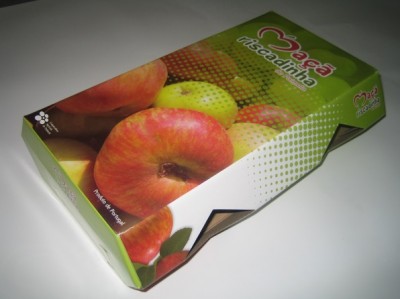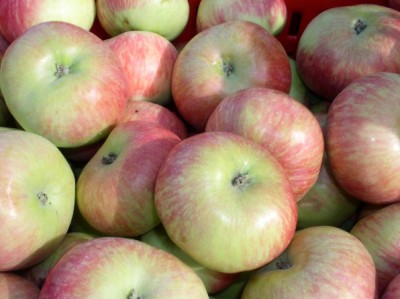Description: ‘Maçã Riscadinha de Palmela’ is an apple of the Riscadinha variety (family Rosaceae, genus Malus Miller, species Malus domestica Borkh.) produced in the region defined. It is intended for consumption fresh, whole and unpeeled.
Only apples which can be graded as class ‘Extra’, I or II (minimum size: 60 mm) may bear the name ‘Maçã Riscadinha de Palmela’.
Production method: Palmela is known as the capital of the Riscadinha apple and the product has a very well established reputation on the market. The specific characteristics of the climate and soil of the area are reflected in the characteristics of the apple. The microclimate created by proximity to the Atlantic Ocean, the River Tagus and the River Sado and the configuration of the Serra da Arrábida, plus the long hours of sunshine, are vital for producing theintense red striping which characterises the product.
The human factor is also decisive in determining the characteristics of ‘Maçã Riscadinha de Palmela’. Local growers know the right cultural practices to apply and how to prune and to determine when the fruit has reached the ideal state of ripeness for harvesting. Harvesting needs to be staggered because the apples do not all attain the same degree of ripeness at the same time. Knowing exactly when is the best time to pick the apples is crucial for obtaining the skin colour which characterises the product.
Special features: ‘Maçã Riscadinha de Palmela’ is distinguished by its slightly flattened, irregular shape, red striping on a yellowish green skin and russeting in the stalk cavity. Fruit grown within the defined geographical area has more intense striping.‘Maçã Riscadinha de Palmela’ has green-tinted flesh, a sweet, tart taste and is very juicy and aromatic. Sometimes it has translucent marks (in which case the apple is said to be ‘azeitada’), a characteristic which is less common in fruit grown in other regions.
Production area: Administratively, the defined geographical area of production comprises the parishes of Canha and Santo Isidro de Pegões in the municipality of Montijo, the parishes of Marateca, Palmela, Pinhal Novo, Poceirão and Quinta do Anjo in the municipality of Palmela and the parishes of Gâmbia-Pontes-Alto da Guerra and São Sebastião in the municipality of Setúbal.
History: The variety of ‘Maçã Riscadinha’ have emerged in the nineteenth century, on locality of Barris, Palmela region. From the 20s of last century, with the cutting of woods, the cultivation of vines in intercropping with Apple expanded into the area of Lau and Algeruz, which also led to an increase in production ‘Maçã riscadinha de Palmela‘. It was in this area that Maçã riscadinha de Palmela‘ began to show, its adaptation to the site and the organoleptic qualities. With the reduction of exports to England of ‘Maçã Espelho’, the ‘Maçã Riscadinha de Palmela’ began to overlap, for its taste characteristics, which is more acidic.
The 'Maçã Riscadinha de Palmela’ is one of the symbols of the region, is known for its excellent and distinctive taste, its use for perfuming the house, due to its intense and unmistakable aroma and for its broad inclusion in the regional gastronomic recipes.
The place names is also proof of the strong link to the region and the importance that this product takes the identification of its people, there in Palmela two streets county with the name of Maçã Riscadinha, one in the parish Palmela and another in Pinhal Novo.
Product specification (pdf)

Producer group
Cooperativa Agrícola de Palmela
Control and certification body
Control plan
Control plan (pdf)
Publication in EU official journal
JOUE C85 23.03.2013
JOUE L310 20.11.2013
Publication in the Portuguese official journal
Despacho n.º 4836/2011, 18 de março
Aviso n.º 4951/2011, 18 fevereiro



